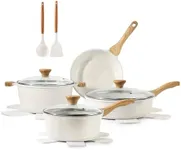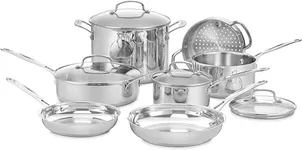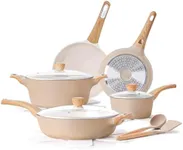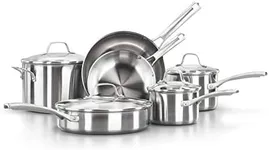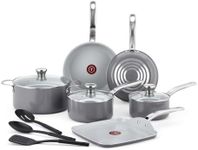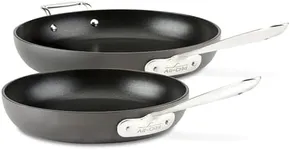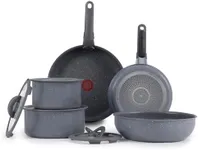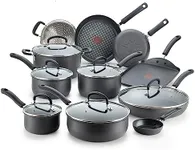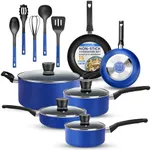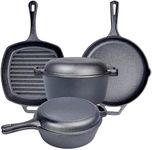Buying Guide for the Best Cookware For Ceramic Stove Top
Choosing the right cookware for a ceramic stove top is essential to ensure efficient cooking and to protect the surface of your stove. Ceramic stove tops are sleek and modern, but they require specific types of cookware to avoid scratches and ensure even heat distribution. When selecting cookware, consider the material, weight, and design to find the best fit for your cooking needs and to maintain the longevity of your stove top.MaterialThe material of the cookware is crucial because it affects heat distribution and the potential for scratching the ceramic surface. Stainless steel is a popular choice due to its durability and even heating. Aluminum is lightweight and heats up quickly, but it should have a smooth bottom to avoid scratching. Cast iron is excellent for heat retention but can be heavy and may scratch the surface if not handled carefully. Non-stick cookware is convenient for easy cleaning, but ensure it has a flat, smooth base. Choose the material based on your cooking habits and the type of dishes you frequently prepare.
Bottom SurfaceThe bottom surface of the cookware should be flat and smooth to ensure even heat distribution and to prevent scratching the ceramic stove top. A flat bottom ensures full contact with the stove top, which is essential for efficient cooking. Avoid cookware with ridges or rough surfaces as they can damage the stove top. When selecting cookware, run your hand over the bottom to check for smoothness and flatness. This is particularly important for maintaining the integrity of your ceramic stove top.
WeightThe weight of the cookware can impact both cooking performance and the safety of your ceramic stove top. Heavier cookware, like cast iron, provides excellent heat retention but can be cumbersome to handle and may scratch the stove top if dragged. Lighter cookware, such as aluminum, is easier to maneuver but may not retain heat as well. Consider your strength and comfort level when handling cookware, as well as the types of dishes you cook. If you frequently prepare dishes that require long cooking times, heavier cookware might be beneficial, but always lift it carefully to avoid damage.
Size and ShapeThe size and shape of the cookware should match the size of the burners on your ceramic stove top. Using cookware that is too large or too small for the burner can lead to uneven cooking and potential damage to the stove top. Ensure that the base of the cookware covers the burner completely but does not extend too far beyond it. This helps in efficient heat transfer and prevents heat from concentrating on one spot, which can damage the stove top. Consider the types of meals you cook and choose sizes that accommodate your most common dishes.
HandlesHandles are an important aspect of cookware as they affect ease of use and safety. Look for cookware with sturdy, heat-resistant handles that provide a comfortable grip. Handles that stay cool during cooking are preferable to avoid burns. Additionally, ensure that the handles are securely attached to the cookware to prevent accidents. If you often move cookware from the stove top to the oven, consider handles that are oven-safe. Your cooking style and safety preferences should guide your choice in handle design.
LidsLids are essential for many cooking tasks, such as simmering and steaming. Choose cookware with well-fitting lids that help retain moisture and heat. Glass lids are popular because they allow you to monitor the cooking process without lifting the lid, which helps maintain a consistent temperature. Ensure that the lids have heat-resistant handles for safe handling. Consider the types of dishes you prepare and whether you need lids that can withstand oven temperatures if you frequently transfer cookware from the stove top to the oven.
